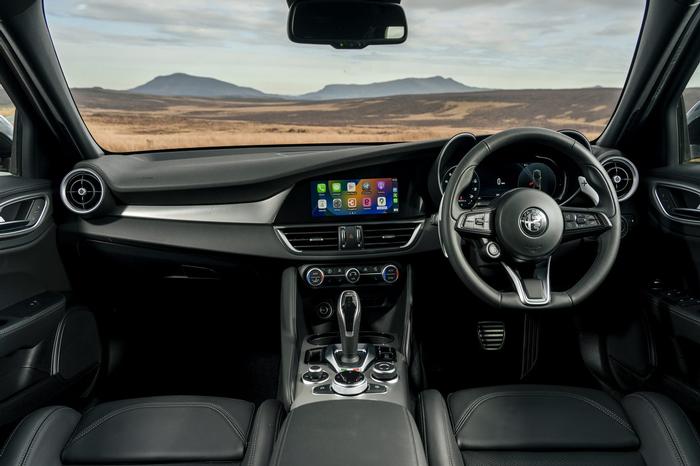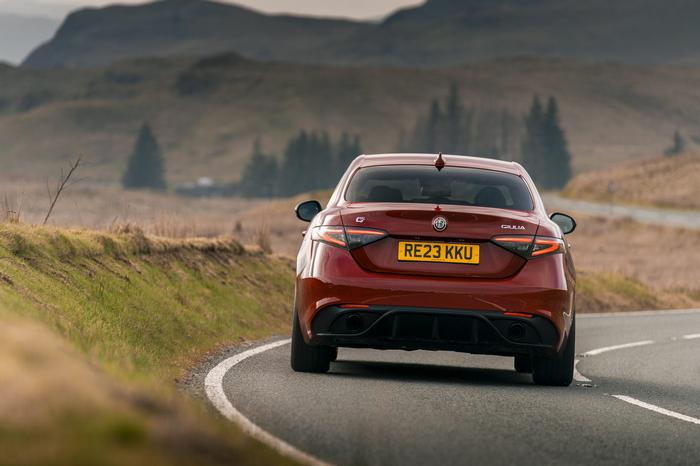2023 Alfa Romeo Giulia Saloon Review

We've tested the updated Alfa Romeo Giulia.
A light update has seen the Giulia adorned with extra technology and some styling tweaks, but will that be enough to catch up with the German class leaders?
Review
Pros: great agility, good looks, practical cabin
Cons: interior feels cheap, dated touchscreen, no hybrid powertrains
The Giulia is Alfa Romeo’s answer to the BMW 3 Series and Mercedes-Benz C-Class – an executive saloon with premium pretensions. For years, it has been one of the best cars in its class to drive, but issues with the interior have held it back slightly. To give the sexy saloon a leg up, Alfa Romeo has updated it with new technology and a lightly revamped nose, but is that enough to put the Giulia in the big leagues?
Alfa Romeo Giulia Design
To the casual observer, the new Giulia looks much the same as the old Giulia, and that’s no bad thing. The curvaceous bodywork has always been a particular highlight, and the Alfa Romeo has long been among the best-looking of all the executive saloons on sale.
However, if you look closely, you will spot some differences, including new headlights with a three-part light signature designed to look vaguely reminiscent of the lights fitted to Alfas of old. Perhaps more practically, the new lights are more in line with the new Tonale SUV, and they come with new technology designed to prevent dazzle for other drivers while still illuminating the road ahead.
But that isn’t all Alfa Romeo has changed. The Giulia has a subtly updated triangular grille at the front, which is another move to bring the car in line with the Tonale, while the other grilles positioned low in the bumper have also been tweaked.
Alfa Romeo Giulia Interior
Perhaps the biggest single update to the Giulia can be found inside, where Alfa Romeo has fitted a new digital instrument display to replace the outgoing car’s analogue dials. Again, it’s inherited from the Tonale, and though it isn’t the most sophisticated system in the world, it looks sharp, and it modernises the cockpit noticeably.
Sadly, that’s pretty much all Alfa Romeo has changed, so there are still issues with the infotainment system, which is starting to show its age. It has all the functionality you need, but it looks a bit dated, and the menus can get confusing. Why Alfa Romeo didn’t import the Tonale’s touchscreen system, which is much more convincing, is a mystery.
On the plus side, the Giulia’s cabin was improved during its last update, and though some questionable materials remain, it’s more competitive than the original car was. And space, which has never been an issue for the Alfa, remains more than adequate. Rear headroom is surprisingly good, even for tall passengers, and the 480-litre boot is on a par with other cars in the class.
Alfa Romeo Giulia Performance & Drive
Unlike most of the Giulia’s rivals, the Alfa Romeo is only offered with one engine. No matter which version you choose, you get a 2.0-litre petrol engine that’s turbocharged to produce 280hp. That drives the rear wheels via an eight-speed automatic gearbox, allowing the Giulia to get from 0-100km/h in less than six seconds. A high-performance Quadrifoglio version is expected to follow soon, offering even greater power.
But for now, it’s 2.0-litre power or nothing, and while the lack of a hybrid option might cause some customers to discount the Alfa, there’s nothing really wrong with the engine. It’s relatively refined and it makes a reasonably appealing noise when pushed, while it still burns less than 7.5 litres of unleaded every 100km.
That solid engine, though, is eclipsed by the real star of the show, which is the way the Giulia handles. It darts from corner to corner with impressive balance and poise, while the suspension is slightly firm without being uncomfortable. It’s a really well-sorted saloon that’s a match for anything else in this sector of the market.
Alfa Romeo Giulia Pricing
Alfa Romeo has not yet confirmed pricing for the new Giulia, but the Italian saloon is expected to come in a choice of three different trim levels. The basic Sprint model comes with part-leather upholstery, a central infotainment screen and the new digital instrument cluster, as well as alloy wheels and climate control. But more upmarket Veloce and Competizione models get lightly altered exterior trim and bigger wheels, as well as more upmarket upholstery and extra equipment.
Carzone Verdict: 4/5
The Giulia is flawed – the interior and technology still isn’t up to the standards set by rivals – but it’s a great car to drive and it looks fantastic. The latest update has brought it a little closer to the likes of the BMW 3 Series, and it remains a viable, if left-field alternative.
2023 Alfa Romeo Giulia Saloon Review

We've tested the updated Alfa Romeo Giulia.
A light update has seen the Giulia adorned with extra technology and some styling tweaks, but will that be enough to catch up with the German class leaders?
Review
Pros: great agility, good looks, practical cabin
Cons: interior feels cheap, dated touchscreen, no hybrid powertrains
The Giulia is Alfa Romeo’s answer to the BMW 3 Series and Mercedes-Benz C-Class – an executive saloon with premium pretensions. For years, it has been one of the best cars in its class to drive, but issues with the interior have held it back slightly. To give the sexy saloon a leg up, Alfa Romeo has updated it with new technology and a lightly revamped nose, but is that enough to put the Giulia in the big leagues?
Alfa Romeo Giulia Design
To the casual observer, the new Giulia looks much the same as the old Giulia, and that’s no bad thing. The curvaceous bodywork has always been a particular highlight, and the Alfa Romeo has long been among the best-looking of all the executive saloons on sale.
However, if you look closely, you will spot some differences, including new headlights with a three-part light signature designed to look vaguely reminiscent of the lights fitted to Alfas of old. Perhaps more practically, the new lights are more in line with the new Tonale SUV, and they come with new technology designed to prevent dazzle for other drivers while still illuminating the road ahead.
But that isn’t all Alfa Romeo has changed. The Giulia has a subtly updated triangular grille at the front, which is another move to bring the car in line with the Tonale, while the other grilles positioned low in the bumper have also been tweaked.
Alfa Romeo Giulia Interior
Perhaps the biggest single update to the Giulia can be found inside, where Alfa Romeo has fitted a new digital instrument display to replace the outgoing car’s analogue dials. Again, it’s inherited from the Tonale, and though it isn’t the most sophisticated system in the world, it looks sharp, and it modernises the cockpit noticeably.
Sadly, that’s pretty much all Alfa Romeo has changed, so there are still issues with the infotainment system, which is starting to show its age. It has all the functionality you need, but it looks a bit dated, and the menus can get confusing. Why Alfa Romeo didn’t import the Tonale’s touchscreen system, which is much more convincing, is a mystery.
On the plus side, the Giulia’s cabin was improved during its last update, and though some questionable materials remain, it’s more competitive than the original car was. And space, which has never been an issue for the Alfa, remains more than adequate. Rear headroom is surprisingly good, even for tall passengers, and the 480-litre boot is on a par with other cars in the class.
Alfa Romeo Giulia Performance & Drive
Unlike most of the Giulia’s rivals, the Alfa Romeo is only offered with one engine. No matter which version you choose, you get a 2.0-litre petrol engine that’s turbocharged to produce 280hp. That drives the rear wheels via an eight-speed automatic gearbox, allowing the Giulia to get from 0-100km/h in less than six seconds. A high-performance Quadrifoglio version is expected to follow soon, offering even greater power.
But for now, it’s 2.0-litre power or nothing, and while the lack of a hybrid option might cause some customers to discount the Alfa, there’s nothing really wrong with the engine. It’s relatively refined and it makes a reasonably appealing noise when pushed, while it still burns less than 7.5 litres of unleaded every 100km.
That solid engine, though, is eclipsed by the real star of the show, which is the way the Giulia handles. It darts from corner to corner with impressive balance and poise, while the suspension is slightly firm without being uncomfortable. It’s a really well-sorted saloon that’s a match for anything else in this sector of the market.
Alfa Romeo Giulia Pricing
Alfa Romeo has not yet confirmed pricing for the new Giulia, but the Italian saloon is expected to come in a choice of three different trim levels. The basic Sprint model comes with part-leather upholstery, a central infotainment screen and the new digital instrument cluster, as well as alloy wheels and climate control. But more upmarket Veloce and Competizione models get lightly altered exterior trim and bigger wheels, as well as more upmarket upholstery and extra equipment.
Carzone Verdict: 4/5
The Giulia is flawed – the interior and technology still isn’t up to the standards set by rivals – but it’s a great car to drive and it looks fantastic. The latest update has brought it a little closer to the likes of the BMW 3 Series, and it remains a viable, if left-field alternative.



